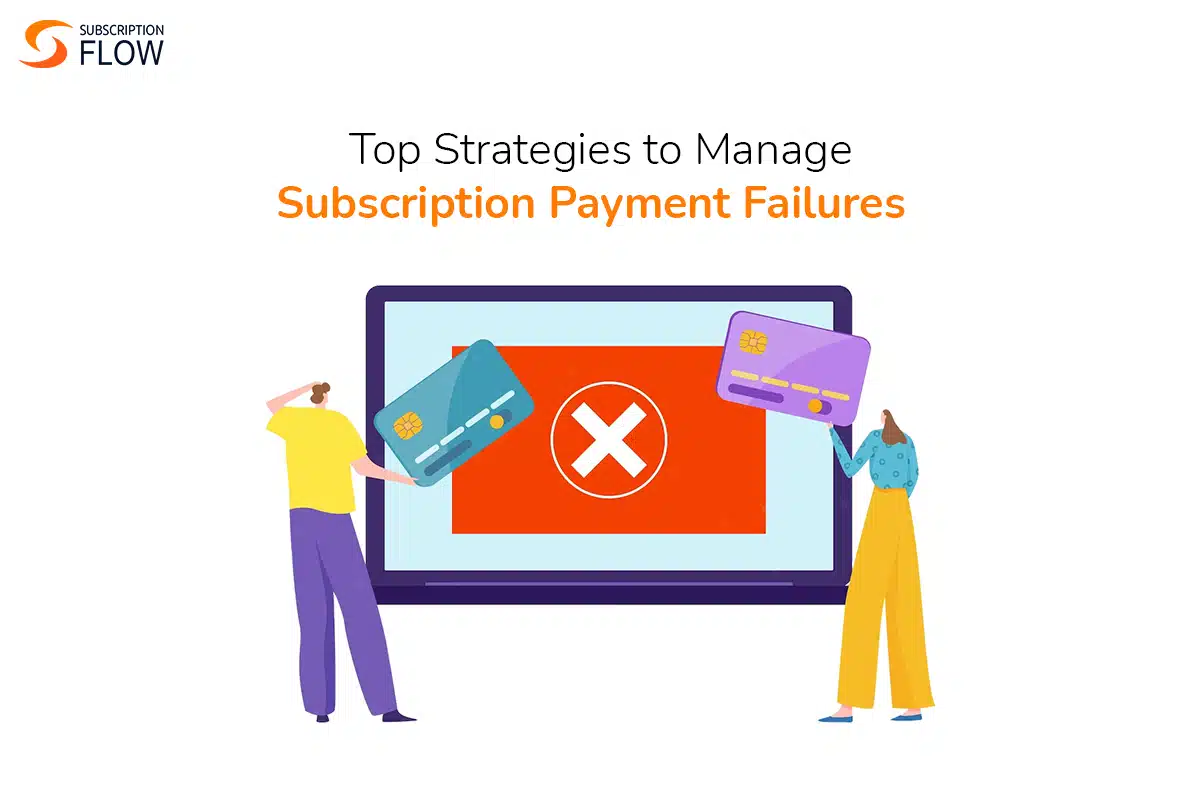
Subscription Payment Failure Management: Top Strategies
Are you frustrated with your SaaS subscription business’s lack of growth, even though your sales and marketing teams are attracting plenty of new customers? It’s possible that you need to focus on customer and revenue retention to truly upscale your business. High churn rates and low customer retention could indicate subscription payment failure i.e payment-related issues, which can result in significant revenue loss and impede growth. To address this, it’s important to strategize how you recover failed payments. In this article, we’ll share ten payment recovery strategies that industry experts swear by, so you can take actionable steps to improve your business. Keep reading to learn more!
The Customer Payments Journey
The payment journey of your customers is the backbone of their subscription journey with your business. It encompasses multiple phases, including discovery, trial, purchase, usage, and renewal, each of which plays a critical role in the customer’s overall experience with your enterprise. Optimizing each phase of the payments journey ensures customer satisfaction, enabling retention, and long-term success for your business.
Leveraging lucrative partnerships with payment providers, improving approval rates by sharing information with issuers through fraud-screening programs, and incentivizing customers to stay through co-marketing relationships are all valuable strategies to drive success. In the renewal phase, the actions your organization takes in response to a failed payment can make all the difference when it comes to your bottom line, which is why the importance of implementing effective payment strategies cannot be overemphasized.
Let’s explore the top 10 payment strategies that industry leaders swear by for recovering failed payments to enable customer and revenue retention.
10 Cutting-Edge Payment Recovery Strategies for Subscription Payment Failure
1. Pre-Dunning Strategy
Having a system in place to remind customers to update payment details that are about to expire is an effective way to nip a failed payment in the bud. This can be done by enabling in-app reminders, through subscription management and automation service providers, and by creating a frictionless and integrated infrastructure for payment processing. Intuitively, if the process of updating payment details is smooth and convenient, your customer is that much more likely to do it themselves. This can save you from the hassle caused by a failed payment that necessitates the rest of the strategies listed here.
2. Automated Dunning
With trusted subscription management and recurring billing platforms such as SubscriptionFlow, you can easily automate dunning strategies to send personalized emails, reminders, or text messages to customers with failed payments, reminding them to update their payment details. This is a simple and robust strategy to recover revenue lost from failed payments and drive down involuntary churn.
3. Account Updater
Expired cards are one of the top reasons for failed payments in the subscription payments industry. The good news is that many payment processors offer card updater services that automatically update your customers’ payment information when their card expires or is reissued. This can help ensure that payments go through even if the customer forgets to update their information.
With an active account updater, you no longer have to worry about involuntary churn and revenue loss from outdated payment information and expired credit cards. The account updater operates both in batches and real-time, the choice of which works better for you depends on your unique business needs.
4. The Magic Date
In the case of acquiring banks or regions such as Latin America that do not utilize account updater services, Matt Wegner, VP of Payments & Risk at Adobe, suggests increasing the expiration date on cards by 12 months. On the SubscriptionShow 2022, he explained how testing different numbers of months, as well as, blank dates allowed Abode to retain 5 million USD in ARR.
Additionally, he revealed a neat trick involving the magic date of December 2099 as a strategy to manage expired cards when an account updater is not available. Setting the expiration to this magic date enables successful transactions facilitating the recovery of failed payments.
5. Provide Alternate Payment Methods
Giving customers the option to pay with alternate payment methods, such as PayPal or mobile wallets, is a great way to prevent involuntary churn from restrictive payment options. Any business aspiring towards global growth must open up its sales funnel to clients with a wide range of preferences in payment methods. Integrating the right payment gateway with your subscription management system allows you to create a frictionless and versatile payment processing experience for your customers.
Read More: https://subscriptionflow.com/2023/02/payment-gateways-for-dummies/
6. Automated Retry Attempts
When a payment fails without an intimation from your customer, confirming that they wish to leave, you must have systems in place to protect them from involuntary churn. The most fundamental first step is to retry the payment. Payment retries can be automated with third-party software such as Vindicia Retain to maximize success in recovering denied transactions and retaining revenue. Some payment gateways also offer this service, despite some limitations. This might be an important factor to consider when choosing the one best suited to your business needs.
7. Optimized Day-of-week for Retries
Particularly when it comes to debit cards, analyzing what day of the week offers better chances of a successful payment retry is also important. Unsurprisingly, the weekend is bad for bank business. Fridays, as well as the 1st and 15th of each month, are generally good choices as these are often the days when people’s salaries flow in. If the transaction was declined due to insufficient availability of funds, you should be able to recover this failed payment once the funds are replenished.
At Adobe, strategists in the payments team found that by scheduling earlier retries on weekdays, particularly Tuesdays, instead of the weekend, Adobe was able to retain upwards of 8 million USD in ARR. Finding the right day of the week for a failed payment retry that offers the best success rate for recovery, depends on the nature of your business, the location of your clients, and many other factors. A/B testing can help identify how to leverage this best day-of-week strategy to maximize approval rates for your business as a powerful strategy for payment recovery.
8. Optimized time of day for Retries
Similar to the day-of-the-week strategy, choosing the right time of day for payment retries is also significant in increasing the chances of successfully recovering a lost payment. Optimizing what time the batch job begins, depending on how long it takes, it is possible to shift the maximum number of transaction processing to global business hours. This is because approval rates at issuing banks are generally higher during the day than during the night with most fraud-screen programs working overtime during these late hours.
Moreover, using different times may result in a higher approval rate for various banks at the BIN level. This offers more potential to monitor and fine-tune your retry strategies to maximize revenue retention success.
9. Network Tokens vs PANs
Network tokens and Primary Account Numbers (PANs) are both used during payment processing through cards. A PAN is a 16-digit number printed on the front of a credit or debit card, identifying the account associated with that particular card. When a customer makes a purchase, the PAN is transmitted to the payment processor, which uses it to authorize the transaction and route it to the appropriate bank for approval.
On the other hand, a network token is a unique digital identifier that can be used to replace the PAN in certain payment scenarios. Network tokens are generated by the card network (e.g., Visa or Mastercard) and are linked to the PAN, but they can only be used for specific transactions and merchants. This makes them more secure than PANs because they are not tied to the actual card number, which could be stolen through fraudulent activity.
Which is better for your business in terms of failed payment recovery? There’s a simple answer and a more complicated one. Network tokens, due to enhanced security generally enjoy a better success rate than PANs globally. So, by shifting from PANs to tokens you can expect to see a neat boost in payment success rates. However, at the BIN level, many banks still prefer PANs and some payment retry strategies do not work with network tokens. This is the reason why experts recommend keeping PANs around and developing a data-driven internal strategy for your own business.
10. The Card Validation Strategy
Card validation by merchants, banks, and other financial institutions, is a crucial step in preventing fraud and unauthorized use of payment details. During payment processing, this refers to the authorization transaction type where a certain small amount is charged and credited back to the customer’s account to check if the card entered is operational.
The $0 verification standard is a good way to go on a basic level, but by leveraging machine learning you can develop a fine-tuned strategy depending on what industry or bank is involved in the transaction. This simple seemingly innocuous step, executed well can transform into millions of USD in revenue retention.
In conclusion, when it comes to upscaling your SaaS subscription business, customer and revenue retention are critical considerations that should not be overlooked. Implementing effective payment strategies is essential in recovering failed payments, ensuring customer satisfaction, and enabling retention. In this article, we have discussed ten cutting-edge payment recovery strategies that industry experts swear by, such as pre-dunning, automated dunning, account updater, providing alternate payment methods, automating retry attempts, and optimizing the day of the week for retries. Optimizing each phase of the payment journey of your customers ensures customer satisfaction and long-term success for your business.










